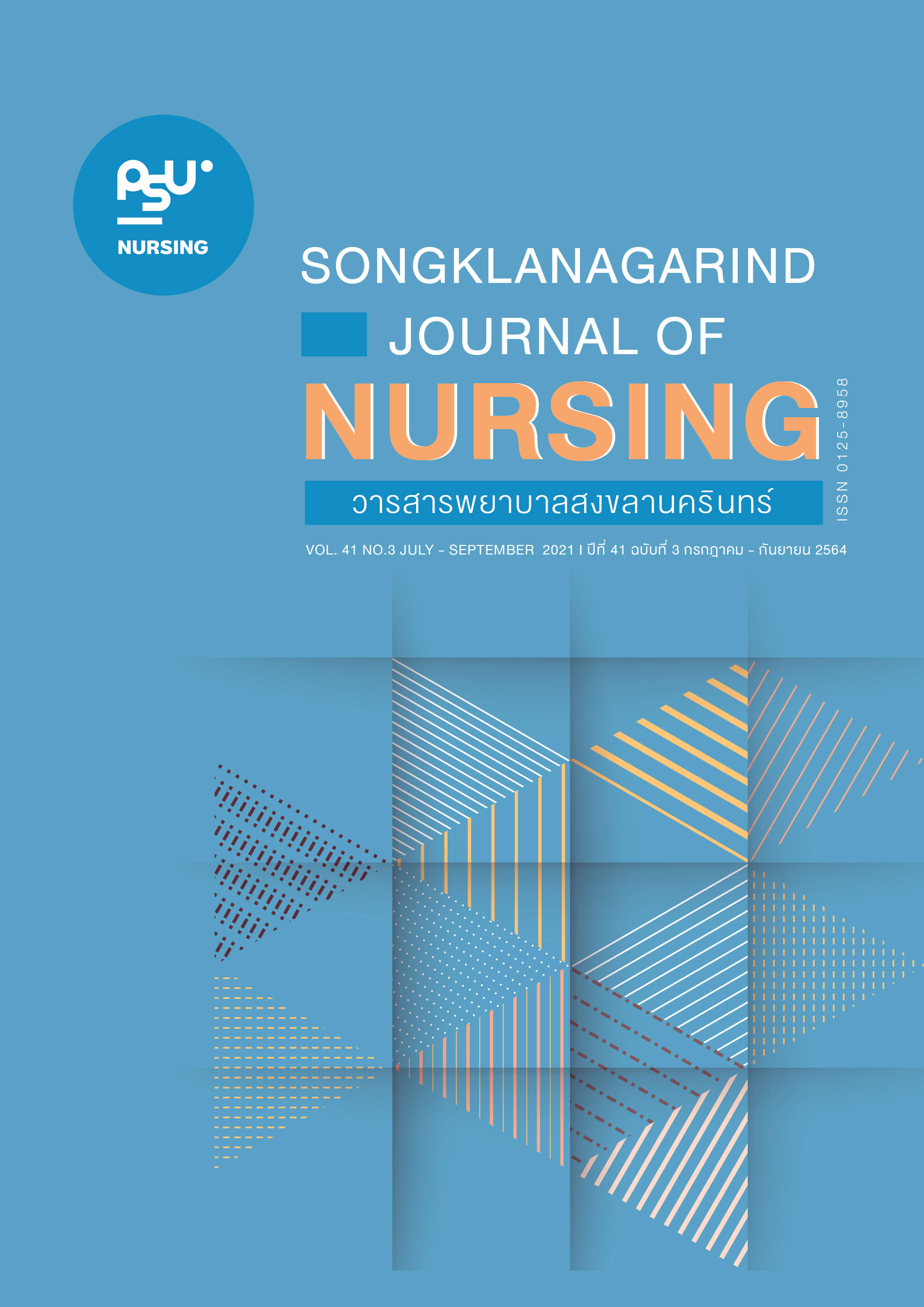Physical Activity Among Pregnant Women in Songkhla Province
Main Article Content
Abstract
Objective: This descriptive research aimed to study physical activity among pregnant women in Songkhla
Province. The sample group consisted of 150 pregnant women. Methods: Data collection was carried out between May-July 2019 using a physical activity for pregnant women questionnaire. The questionnaire contained 4 aspects, asking about household activity, transportation activity, occupational activity, and leisure-time/exercise activity. The score of physical activity was multiplied by number of days that had physical activities. The unit of the score is hours/weeks, which pregnant women who had physical activity below 2.50 hours/weeks considered to has insufficient physical activity. The content validity of the questionnaire was examined by 3 experts. The collected data was analyzed by using descriptive statistics. Results: The results found that the pregnant women had a highest score at 49 hours per week in household activity and 22% of pregnant woman had insufficient physical activity. Additionally, 98.67%, 88%, and 84.67% of pregnant women tended to have insufficient physical activity in transportation activity, occupational activity, and leisure-time/exercise activity respectively. Conclusion: The pregnant women still has insufficient physical activity, which required some support in order to have enough physical activity throughout the pregnancy period.
Article Details
References
The committee of master plan for promoting national physical activity. Master plan for promoting national physical activity A.D. 2018-2030. Bangkok: NC Concepts Ltd; 2018. Thai.
Buranapuntalug S, Yuenyongchaiwat K. Correlation between respiratory muscle strength and the global physical activity questionnaire among monks at Rangsit City Municipality: A preliminary study. Journal of Health Science. 2017; 26(suppl 1): S46-S53. Thai.
WHO. Physical activity. Geneva: World Health Organization; 2018.
Committee on Obstetric Practice. Physical activity and exercise during pregnancy and the postpartum period. ACOG. 2015; 135(4): e178-88.
Liangruenrom N, Topothai T, Topothai C, et al. Do Thai people meet recommended physical activity level?: The 2015 national health and welfare survey. Journal of Health Systems Research. 2017; 11(2): 1-16. Thai.
Puttaraksa S, Supavititpatana B, Kantaruksa K. Attitudes, subjective norm, perceived behavioral control and intention to exercise among pregnant women. Nursing Journal. 2016; 43(3): 24-34. Thai.
Merkx A, Ausems M, Bude L, et al. Factors affecting perceived change in physical activity in pregnancy. Midwifery. 2017; 51: 16-23. doi: 10.1016/j.midw.2017.05.007.
Stefani L, Mascherini G, Galanti G. Indications to promote physical activity during pregnancy. J Funct Morphol Kinesiol. 2017; 2(3): 31. doi: 10.3390/jfmk2030031.
Santos PC, Abreu S, Moreira C, et al. Physical activity patterns during pregnancy in a sample of Portuguese Women: A Longitudinal prospective study. Iran Red Crescent Med J. 2016; 18(3): e22455. doi: 10.5812/ircmj.22455.
Newton R, May L. Adaptation of maternal-fetal physiology to exercise in pregnancy: The basis of guidelines for physical activity in pregnancy. Clin Med Insights Womens Health. 2017; 10: 1-12. doi: https://doi.org/10.1177/1179562X17693224.
Adeniyi AF, Ogwumike OO, Osinike CI. Physical activity and energy expenditure: Findings from the Ibadan pregnant women’s survey. Afr J Reprod Health. 2014; 18(2): 117-26.
Okafor UB, Goon DT. Physical activity and exercise during pregnancy in Africa: A review of the literature. BMC Pregnancy and Childbirth. 2020; 20(1): 732 doi: https://doi_org/10.1186/s12884-020-03439-0.
Harrison AL, Taylor NF, Shields N, et al. Attitudes, barriers and enablers to physical activity in pregnant women: A systematic review. J Physiother. 2018; 64(1): 24-32. doi: 10.1016/j.jphys.2017.11.012.
Liangruenrom N, Suttikasem K, Craike M, et al. Physical activity and sedentary behaviour research in Thailand: A systematic scoping review. BMC Public Health. 2018; 18(1): 733. doi: 10.1186/s12889-018-5643-y.
WHO. Global recommendations on physical activity for health. Geneva: World Health Organization; 2010.
Winichagoon P, Pongcharoen T, Rojroongwasinkul N, et al. Promoting early life nutrition intervention within maternal and child health care (1 st year) [Internet]. Bangkok: Health Systems Research Institute; 2018 [cited 2019 Apr 9]. Available from: http://kb.hsri.or.th/dspace/handle/11228/4867.
Mottola MF, Davenport MH, Ruchat S-M, et al. 2019 Canadian guideline for physical activity throughout
pregnancy. Br J Sports Med. 2018; 52: 1339-46. doi: 10.1136/bjsports-2018-100056.
Kirk RE. Experimental designs: Procedures for the behavioral science. 3 rd ed. Boston: Brooks/Cole
Publishing Company; 1995.
Haruna M Matsuzaki M, Shiraishi M, et al. Physical exercise during pregnancy and its related factors: An observation study in Japan. Asian/Pacific Island Nursing Journal. 2017; 2(4): 166-73. doi: https://doi.org/10.9741/23736658.1074.
Nascimento SL, Surita FG, Godoy AC, et al. Physical activity patterns and factors related to exercise during
pregnancy: A cross sectional study. PLoS ONE. 2015; 10(6): e0128953. doi: 10.1371/journal.pone.0128953.
Mukona D, Munjanja SP, Zvinavashe M, et al. Physical activity in pregnant women in Africa: A systematic
review. Int J Nurs Midwifery. 2016; 8(4): 28-34. doi: 10.5897/IJNM2015.0196.
Merkx A, Ausems M, Bude L, et al. Factors affecting perceived change in physical activity in pregnancy.
Midwifery. 2017; 51: 16-23. doi: 10.1016/j.midw.2017.05.007.
Hesketh K, Evenson KR. Prevalence of U.S. pregnant women meeting 2015 ACOG physical activity guidelines. Am J Prev Med. 2016; 51(3): e87-9. doi: 10.1016/j.amepre.2016.05.023.
Xiang M, Zhang J, Liang H, et al. Physical activity and dietary intake among Chinese pregnant women: an
observational study. BMC Pregnancy Childbirth. 2019; 19: 295. doi: https://doi.org/10.1186/s12884-019-2452-y.
Hayman M, Short C, Reaburn P. An investigation into the exercise behaviours of the regionally based Australian pregnant women. J Sci Med Sport. 2016; 19(8): 664-8. doi: 10.1016/j.jsams.2015.09.004.
Wijesiriwardana WS, Gunawardena NS. Knowledge, attitudes and practices regarding antenatal exercises among pregnant mothers attending De Soyza Maternity Hospital Colombo. Sri Lanka Journal of Obstetrics and Gynaecology. 2015; 37(4): 65-71. doi: http://doi.org/10.4038/sljog.v37i4.7773.
Pathirathna ML, Sekijima K, Sadakata M, et al. Impact of second trimester maternal dietary intake on gestational weight gain and neonatal birth weight. Nutrients. 2017; 9(6): 627. doi: 10.3390/nu9060627.
Silva SG, Evenson KR, Silva KR, et al. Correlates of accelerometer-assessed physical activity in pregnancy-The
Pelotas (Brazil) birth cohort study. Scand J Med Sci Sports. 2018; 28(8): 1934-45. doi: 10.1111/sms.13083.
Santo EC, Forbes PW, Oken E, et al. Determinants of physical activity frequency and provider advice during
pregnancy. BMC Pregnancy Childbirth 2017; 17(1): 286. doi: 10.1186/s12884-017-1460-z.


